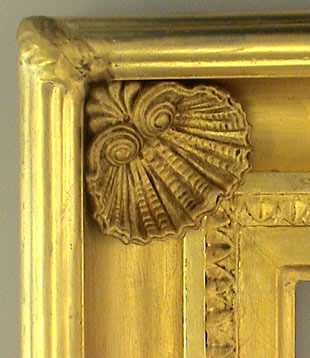< Conservation of Gold Leaf Frames
About My Frame Conservation ServicesFrame Conservation Gallery
Caring for Your Gold Leaf Frames

Conserved surface with restored corner ornament
Caring for Your
Gold Leaf Frames
Frames and other gilded objects are deceptively fragile and require cautious maintenance. Water-gilded surfaces can be ruined by touching with damp hands or by rubbing with a cloth. The oil gilding technique or the application of a protective varnish creates a more durable surface, but still the gold is easily scratched or can be worn away through routine cleaning. Often a frame combines various gilding techniques and varnish options, and a lucky successful cleaning in one area can lead to disaster elsewhere. Instead, clean your gilded frames gently and infrequently, and do not use water or any other cleaners. Gentle dusting several times a year should be sufficient.
Worrisome layers of gesso and clay bole lie beneath the gold leaf surface. These layers of clay and calcium carbonate mixtures behave like fragile plaster. They are easily crushed or gouged, and are prone to crumbling and cracking. Changes in humidity can cause these layers to flake, and with the flaking gesso goes the gold leaf. Protect this fragile ground under the gold leaf by avoiding locations near heat registers or windows, above fire places, and other places with fluctuating temperature and humidity. Hang and store your frames with care and kindness.
The decorative leaves and flowers, shells, corner ornaments, and architectural moldings on your frame usually are made as separate components and are attached prior to gilding. Over time these ornaments can become loose or fall off completely. Do not reattach these pieces. Any glue, tape, nails, or miracle products will make matters worse, as the damaged gold leaf and ground layer is more fragile now than before. Keep all such pieces in a small box or envelope until proper conservation is arranged.
Finally, touching up a damaged gold leaf frame rarely is satisfactory. Gold colored paints and waxes may help the appearance somewhat for a short time if the color match happens to be just right. But this is rarely the case and the benefit is short lived. These materials do not contain real gold, but copper alloys that can resemble gold until they begin to oxidize. Then they turn brown, green, or black. It is better to leave cosmetic damage alone until correct materials can be used to minimize damage and improve the appearance. Additionally, the time required to remove such paints, polishes, and waxes adds substantially to the cost of conservation, and sometimes these materials ruin a surface that otherwise might have been salvaged.